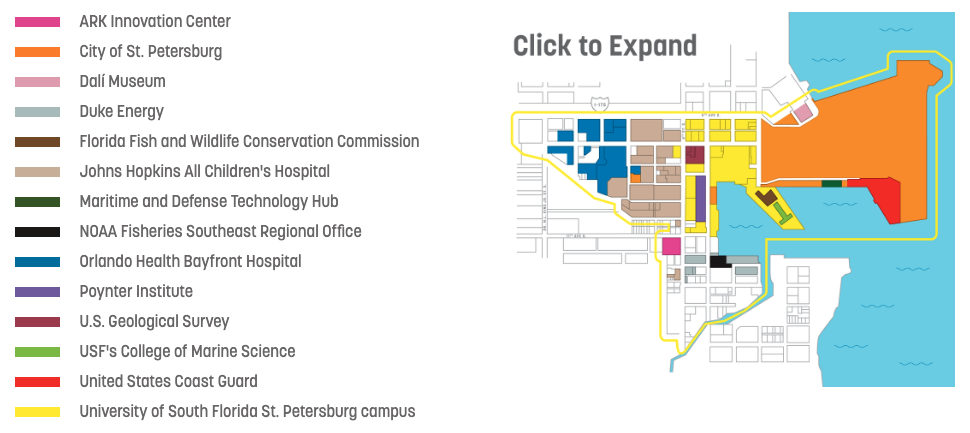After a hiatus due to the Covid-19 pandemic, the St. Pete Innovation District resumed its quarterly trolley tours in 2023, offering a glimpse into the businesses and organizations bringing cutting-edge research and innovation to St. Petersburg.
The Innovation District originally launched the tours in September 2017, and they ran through 2019, pausing in early 2020 in response to Covid.
The quarterly tours offer 20-minute stops at various locations throughout the Innovation District. The most recent tour, on May 17, kicked off at the Maritime and Defense Technology Hub, a collaborative space fostering advancements in maritime, defense and environmental technologies. Participants got an introduction to the Innovation District itself from Alison Barlow, Executive Director of the St. Pete Innovation District, along with a presentation from lunar startup Lonestar, one of the two dozen tenants at the Hub.
“The Innovation District was formed in 2016 by the employers of the area, and they were really looking for ways to grow economic development,” Barlow explained. “They thought of it in two [areas]. One was job growth: how do we create more jobs, whether that’s growing existing businesses or attracting new businesses? And then the other was around learning and inspiration. How do we increase the number of grants that are coming here, because those spur research which then can spur jobs.”


The St. Pete Innovation District is a designated 0.83 square mile area located south of downtown St. Petersburg. Screengrab from St. Pete Innovation District website.
The St. Pete Innovation District has more than 50 member organizations, including universities, hospitals, research centers and technology companies, many of which have a footprint in the district. Others, like the Foundation for a Healthy St. Pete, are not physically located within the district’s boundaries but collaborate on activities that match its mission.
“What we’re trying to do is create an epicenter here, but we connect to partners outside the district who have a logical reason for collaboration,” Barlow said.
After the introduction at the Hub, about a dozen participants boarded the trolley and made their way to the Dali Museum. This stop offered a glimpse into the museum’s efforts to incorporate technology like artificial intelligence and machine learning into its mission of preserving and showcasing Spanish artist Salvador Dali’s surrealist masterpieces. Beth Harrison, Digital Experiences Director of the museum, also spoke about the proposed 60,000 sq. ft., $68 million expansion, which she said will focus on digital art experiences.
The tour then proceeded to Johns Hopkins All Children’s Hospital, where the group toured the pediatric healthcare facility’s Simulation Center, where future healthcare professionals practice what they’ve learned in the classroom, and current doctors and nurses learn new skills and practice surgeries and situations before putting them to use in real-life.
The facility includes physical tools and technology, like a 3D printer that would allow a surgeon to print an exact replica of a patient’s internal organ, and rooms that mirror the patient care rooms inside the hospital, immersing healthcare professionals in practice scenarios they may encounter outside the simulator.


One of the rooms at the Johns Hopkins All Children’s Hospital’s Simulation Center is designed to look and feel like the back of an ambulance. A pediatric hospital bed is placed inside, giving healthcare professionals the experience of practicing their skills in a small space. Photo by Ashley Morales.
Next, the tour proceeded to the University of South Florida’s (USF) STEM Lab at the St. Petersburg campus. Here, participants explored the university’s efforts in promoting science, technology, engineering and mathematics (STEM) education and research, shaping the next generation of innovators and problem-solvers. Administrators want the lab to integrate STEM across all of the university’s degrees and disciplines, hosting professional development classes and workshops.
In addition to its existing robotics program, the USF STEM Lab is in the process of finishing a virtual reality buildout. The new section is outfitted with multiple computers and VR headsets, all linked to display monitors throughout the room, allowing for teaching and learning opportunities.
The four-hour tour capped off with a reception at the Maritime and Defense Technology Hub. By offering these immersive tours, the St. Petersburg Innovation District team aims to showcase the city’s vibrant ecosystem of innovation, fostering collaboration and inspiring curiosity for residents and visitors.
Barlow said they have not yet set the date for the next quarterly trolley tour, but it will be announced on the Innovation District’s website and in its monthly newsletter.
.
